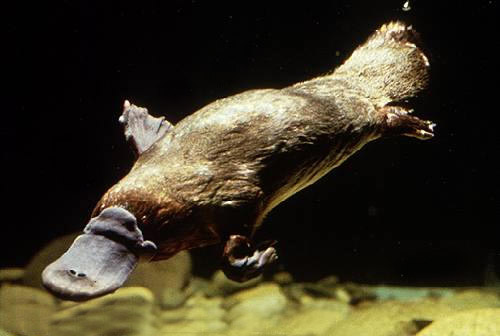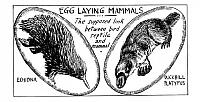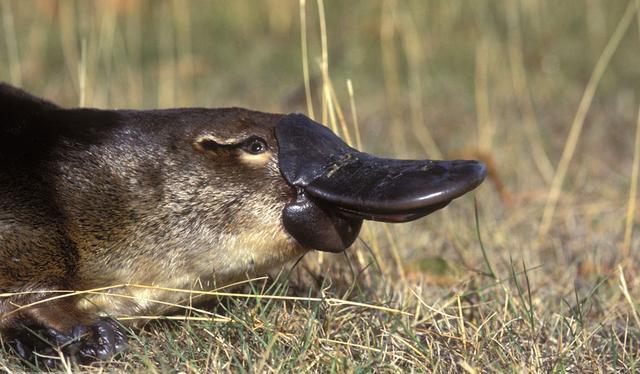
An animal which has a bill like a duck, fur on its body, coarse hair on its tail, webbed feet, claws for burrowing, spurs connected to poison glands, which lives in the ground, feeds in the water, lays eggs and suckles its young- will never cease to create interest and wonderment. Such is the platypus!
Australia has many strange creatures, but the platypus stands out unique and incomparable. It is confined to the eastern rivers of Australia and also to Tasmania.
Platypae are fairly numerous in the Healesville district of Victoria and Eungella in Queensland’s north.
Description of the Platypus
The body of the platypus is surprisingly small, but the thick and loose skin gives the impression that it is a creature of some bulk. The upper and lower portions of the body are covered with soft fur. The back and sides are usually of a reddish-brown colour, shading to an attractive yellow-silver on the underside. Some of the older male animals are very dark. The female is always smaller than the male and easily distinguishable.
The tail of the platypus somewhat resembles the beaver. It is a very powerful organ and plays an important part in enabling the platypus to effect rapid movements, one of its strong characteristics. The platypus is able to dive at an incredible speed and submerge at a rapid rate. The tail acts as a rudder and assists in burrowing. The hind feet play their part in balancing and keeping the body in position.
The front feet are used in swimming and the webbed feet resemble a fan. The platypus swims and dives at a moderate speed, at a rate of about 40 feet per minute.
Burrowing is achieved by utilising the tender looking bill and front feet. It is possible that the bill does most of the work in loosening the soil and the claws act as rakes. The platypus makes its burrow in the river banks and the burrows are occasionally carried considerable distances. They have been known to exceed 100 feet, but on average 25 – 30 feet in length. The entrance to the burrow can easily be identified, for its form is different from that made by any of the other burrowing animals. The entrance is surprisingly small and if one were not familiar with the platypus and its small body, it would seem that the animal could not possibly enter such a small opening. A noteworthy feature of the burrow is that there is no accumulation of of earth outside as is usually found at burrows made by other animals.
The female prepares a nest at the end of the burrow, by first scooping out ample soil and then lines it with various materials, such as leaves etc. It is assumed that many journeys are made while constructing the nest, as the platypus does not have a great carrying capacity. The platypus lays two small eggs about the size of a pigeon egg and they are of reptilian appearance. The eggs hatch out within 21 days at the period of nesting . The platypus takes up a head to tail position in the nest with the eggs held safely and snugly against the body.

The platypus is a mammal, yet there is no external evidence of it. The glands enable the nourishment, or milk, to exude through the skin and the young receive it in this manner.
The hind feet of the platypus are extraordinary in their formation. They have a splayed tendency and give the impression that a backward and not a forward movement would be most natural. The feet have strong gripping powers. The claws are sharp and are hooked in a lateral direction. This being the case, when the platypus takes hold of an object in which the claws can function, great power or strength is attained.
The joint of the hip is a truly remarkable one, for it can use it’s hind feet in such a way that when grooming itself the foot can be turned so that it can reach any part of its body.
When cleaning or grooming, the claws of the hind feet are brought close together in the form of a comb. It is used in such a way that every portion of its fur gets a thorough cleansing. The platypus is a very clean animal and spends a lot of time in the frequent periods in which it indulges in the grooming process. After feeding and before retiring to the sleeping chamber, the platypus combs most of the water from its fur, thus enabling it to retire in a comparatively dry state.
The bill of the platypus has, at first appearance, a strong resemblance of that of a duck. On closer examination it will be found that there are very marked differences. The bill of the duck is harder than that of the platypus. The tip or end of the bill of the platypus is soft and pliable, similar to soft rubber. This rubber like covering extends upwards and downwards. On the upper side it forms a shield like flap up that front of the head. On the lower side it takes a similar form and extends for some distance along the throat. It is not very clear what purpose these flaps serve, but it may be that the extensions are of assistance when digging into clay or mud.
If this animal is startled – as is often the case – it immediately submerges and remains so for varying periods. If a careful watch is maintained about the area of submersion, it will be noted that a portion of the bill will very quietly extend above the surface of the water. No portion of the body can be seen and the nostrils are just sufficiently clear of the water for breathing purposes. Two things suggest themselves. Firstly that the platypus has a highly specialised olfactory sense which enables it to sense danger and so guard against it while the bill is exposed – for we must remember that the platypus’ eyes and ears are closed under water and these, in consequence, do not function.
Secondly, has the platypus some unknown sense which enables it to detect certain dangers which may menace its existence?
The platypus is a strange animal, and we must be prepared for strange behaviour.
A full-grown platypus cannot exist on less than 16 ounces of worms per day while in captivity – how and where does the platypus obtain such a quantity of food in the rivers? It may be that the animal does not need such a quantity in its natural haunts. The platypus, like other animals, requires a balanced ration ie fats, proteins, carbohydrates etc in order to sustain life. Freshwater shrimps and larvae of various kinds would be readily available in the murky waters. In addition, the countless millions of winged insect life which fall into the water, would provide a good supply. Quantities of small creatures would be carried into streams after heavy rainfall and again provide food for the platypus.
The platypus is exceedingly fond of tadpoles and will eat them in preference to worms or grubs. Platypus have been found on dry land – the stress of hunger or a desire for a change of food may be the reason for them being found away from rivers or any other of their usual haunts. In the pools of water they would find a diversity of life, including tadpoles, all of which would be eagerly devoured. .
The platypus does not have teeth, but has the edges of the bill serrated in such a way that the action of dealing with their food is of a grinding nature. The food is ground into a pulp before being disposed of. In dealing with large worms, it uses its front feet in assisting to break them up.

The platypus has great strength. It can push aside heavy objects and at times finds itself in very narrow passages. It turns on its side so that the body acts as a wedge.
The auditory sense of the platypus is developed to a high degree of efficiency. Most observers of the platypus along the rivers will have realised that acuteness. The slightest sound – even at a considerable distance – results in an amazingly rapid disappearance.
Spurs – it would appear that these are used for offensive and defensive action and they are well suited for such purpose. It has also been suggested that the spurs are used to grasp the female during the mating season!
The platypus is a monotreme . The name monotreme means “one holed”, referring to the cloaca, a single hole that serves the urinary tract, anus and reproducttve tracts. Monotremes are in some way primitive, they lay eggs rather than producing live birth. Like other mammals, monotremes have a single bone in their lower jaw, three inner ear bones, hair and produce milk to feed their young.
There are only three species of monotremes, that being the platypus, the spiny anteater and the echidna from Australia.
“In closing, one would like to feel that the platypus will not be exterminated. If it should occur it would be a calamity of some magnitude, for it would deprive the world of its most wonderful animal” (such were the words of Robert Eadie).
Up to the present the platypus appears to be holding its own and if all would unite in taking the necessary steps to preserve it, there is no good reason why it should not survive indefinitely. There is, of course, always the danger of disease thinning ranks, as it has done with many other animals in Australia “
However, under ordinary conditions and provided it is not molested, there is no good reason why it should not only live, but multiply, for it can look after itself as well and, perhaps, better than most other creatures in the wild.
It cannot be denied, though, that the natural protection or cover is, in many places, slowly but surely diminishing.
There was a time and not so very long ago, when nearly all river banks were sanctuaries for the platypus and other interesting creatures” (The Platypus, Its Life and Habits” by Robert Eadie).